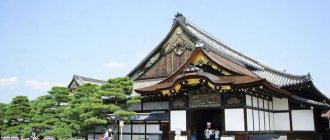The story of a girl who was looking for “that same” apartment in Japan.
Today, Cindy is an employee of the Tokyo real estate agency Real Estate Japan and the GaijinPot Housing Service project, which helps foreigners find their new home in Japan. She moved to Japan immediately after graduating from De La Salle University in the Philippines and experienced first-hand all the problems people face when looking for an apartment in the Land of the Rising Sun. Below, Cindy shared the story of how she searched for her dream apartment and researched the features of Japanese apartments.
When I arrived in Japan, I dreamed (and still dream!) of finding the perfect apartment. Right before moving, I became addicted to the TV series “Shiawase! Bonbi Girl! and looked for every detail in it that would help me in the upcoming search for housing.
"Shiawase! Bonbi Girl! is an entertaining series aimed at young girls who don’t have much money. It has sections dedicated to DIY projects, as well as those about women living in affordable housing, and sometimes about entrepreneurs planning their own businesses. But what interested me most was 上京ガール - Joukyou Girl - where the film crew accompanied girls who had just arrived in Tokyo from other prefectures in Japan in search of their first apartment. Of course, I tried to remember as many key points and tips as possible in the hope that they would help me find my ideal Japanese nest.
After landing in Tokyo, they put me in an apartment, and then they informed me that it was only for a month and that soon I would have to look for new housing on my own. With the help of my aunt, I made my first attempt (long before I started working at Real Estate Japan, a real estate sales and rental company). Even though I was confident I knew what to expect, going through it all on my own was a completely different experience, with many more discoveries and challenges than what was shown on the show.
Below I will talk about 8 features that are typical for apartments in Japan. They may come as a surprise to you, especially if you come from another country.
How do the Japanese live?
Many young Japanese, growing up, decide to continue to live with their parents, rather than strive for separate and independent living. This phenomenon is called the solitary parasite (パラサイトシングル) . A 1998 study by the Department of Health and Human Services shows that about 60% of single men and 80% of single women aged 20 to 34 live with their parents. And after marriage, young couples often continue to live with their parents. And the desire of some for separation led to the emergence of such a phenomenon as nisedaijutaku (二世代住宅) , which literally means “housing for two generations,” i.e. this is a house in which there are two living spaces completely fenced off from each other - one each for a young family and its parents. Conversely, in neighborhoods in major cities in Japan, it is no longer uncommon for couples to live together long before marriage.
Traditionally, old people continue to live with their children rather than being placed in nursing homes by loving relatives. Responsibility for parents usually falls on the shoulders of the eldest son (atotsugi, 跡継ぎ) . The large number of elderly people living in the country has led to the emergence of a large number of home care products, as well as so-called “barrier-free” housing, in which distances are short and contain virtually no barriers for the elderly.
Housing exchanges between strangers are rare in Japan, and most people prefer to live in small, separate apartments. However, in recent years, as Japan has undergone ongoing demographic and socioeconomic changes, it has become common for young people to change apartments.
Apartment designs are many and varied: older apartments resemble a long, thin shoebox with the kitchen and bathroom located close to the living room and hallway while the bedroom is at the opposite end, which may also have a small balcony.
Japanese companies often send their employees to various branches scattered throughout Japan. Such a transfer requires the entire family to move to a new place of work, which is not always possible. And then a small apartment is rented for the breadwinner of the family, who then goes home to his wife and children on weekends.
Lofts. Lots of lofts
1Gai.Ru /
/shutterstock.com
Lofts are something I already knew about (of course, lofts are a trend in many other cities and countries where every square meter is important). Since Japanese apartments are notoriously very, very small, they are designed to make the most of available space. When it is impossible to expand horizontally, there is only one thing left: to make apartments higher. That's why there are so many lofts now.
I believe lofts in other countries have built-in stairs leading to the second floor, which is not completely separate from the first floor. However, second levels in Japan, especially Tokyo, are connected by staircases that can be removed. Surprisingly, this is a useful feature, especially when you need to make room for furniture or guests.
The “attic” space in studio apartments ranges in size from two to seven tatami mats (畳). A tatami mat is approximately 1.53 square meters. m. Someone (and the majority of such people) uses the second floor as a “bedroom”, others - as a place to store things. I guess this makes sense if you are afraid of heights.
Project 1.8M Width House
Project 1.8M Width House by YUUA architectural studio. Photo: YUUA
Project 1.8M Width House by YUUA architectural studio. Photo: YUUA
Some Japanese architects, such as Kazuo Shinohara, Kazunari Sakamoto and Atelier Bow Wow, have dedicated their entire careers to small-scale residential projects. They wanted to create a love for domestic space and show its importance to modern architecture.
Interior of the 1.8M Width House project by YUUA architectural studio. Photo: YUUA
Interior of the 1.8M Width House project by YUUA architectural studio. Photo: YUUA
Maisonette
bukkenfan.jp/renoverisu.jp/08group.com
A maisonette (メゾネット) is essentially an apartment on the second floor with an entrance on the first floor. A maisonette is also a name for a two-level apartment in which the bedroom is located on the second floor and can be reached via an internal staircase.
I wouldn't say there are many such options in the real estate market in Central Tokyo, but this type of housing is very common in the suburban areas of Setagaya or Nakano.
I know some people don't like their bedroom being visible as soon as the front door opens - for them a maisonette would be ideal. It also adds a +1 to peace of mind knowing that your outdoor shoes are far away from your actual living space.
However, living in a maisonette can be a problem if you arrive home tired after a long day at work.
And, of course, it is difficult to move large furniture or household appliances there. But if these points do not bother you, then a maisonette is your ideal option in Japan. see also
10 facts that distinguish Japan from other countries: local features and figures
Building a house
Many single-family homes are built by (now finally renamed Panasonic), Misawa Home, Mitsui and Sumitomo Forestry. Some such companies show portfolios to potential buyers and open showrooms to showcase their products.
Construction Materials
Wooden frames are very popular for detached houses. The two-by-four design is an alternative to the traditional Japanese style. Houses can be sheathed in some material or covered with ceramic tiles, which can be of various colors and covered with glaze.
Walls are often erected without using mortar, i.e. using the dry masonry method and covered with paint or wallpaper. A common roof covering option is shingles, which are made from clay or concrete.
Large buildings are usually built from reinforced concrete, and their roofs are filled with bitumen or covered with synthetic materials.
Rules for building a home
Typically, the allowed maximum for wooden houses in Japan is two stories. Some of these houses may have an attic, but it is used only for storage space; no one has bedrooms there - unlike our village houses.
Buildings made of reinforced concrete can have a larger number of floors, but as a rule, they are also limited to two. Foundations for private houses are rare, but absolutely required when constructing high-rise buildings.
The ratio of the building area, including the area of the house itself and the plot of land on which it is built, is regulated in accordance with a system called kenpeiritsu (建ペイ率) . For example, in some areas the built-up area may only be 80% of the total land area. Depending on the location, kenpeiritsu may vary.
The taxable value of the house also includes the building material from which the house was built. Timber houses are considered to have a lifespan of 20 years, but in some cases the lifespan can be as long as 30 years. Their assessed value, accordingly, decreases every year - in contrast to the housing market in other countries. Most real estate agents use this pricing policy as a guideline.
The equipment is located next to the entrance
realestate.co.jp/helgashjem.exblog.jp
Again, due to the need to maximize the efficiency of space use, there are apartments that are specifically designed to accommodate certain furniture and appliances.
For example, I live in an apartment where there is a specially designated place for a washing machine, located right at the entrance. I think some people won't be bothered by this feature, but at the same time it can be a real problem for those who are obsessed with their hygiene. So this is also worth paying attention to when choosing housing.
Traditional housing
In old Japan, commoners typically lived in detached houses, now known as minka , or in towns, machiya (町屋) or longhouses called nagaya (長屋) . You can find examples of both, in particular in Kyoto.
Additional residential buildings were included in the homes of samurai, wealthy peasants, and on the grounds of Buddhist temples. Wood served as the basis of such houses, and the roof could be covered with straw, cypress bark, tiles or unfinished wood. The floors raised above ground level were made of wood, and in living areas they were covered with tatami mats. The kitchen, as a rule, had an earthen floor.
The washing machine is located on the balcony or behind the front door
tripadvisor.jp / tripadvisor.com
For most apartments, this is the norm when the washing machine is installed inside the apartment. But it also happens (especially in small and inexpensive apartments) that the place for it is outside the living space - on the balcony or behind the front door.
For those who are afraid of theft or don't want to get wet while doing laundry during the rainy season, this can be a headache. And if you're willing to take the risk, you can save a little on rent.
The apartment is rented without equipment
homes.co.jp/rakumachi.jp
When you look at photos online or tour apartments in person, you may be surprised to learn that many apartments in Japan do not have ovens, lights, or air conditioning. Reason: Some tenants have their own views on things and prefer to buy equipment themselves.
When you are looking at an apartment, be sure to check with the administration whether it has the devices and equipment that you need. Otherwise, you must factor it all into your move-in costs. Typically, most rental properties in Tokyo already have air conditioning installed.
Bathrooms in Japanese apartments
I think bathrooms are a different topic for discussion! The Japanese pay special attention to the place where they wash, so it would be a good idea to find out a little more detail about these rooms. Below you will find a few of them.
Toilets are separate from the bathroom
bath-room.net / rehome-navi.com
This is the most common feature of Japanese bathrooms and may surprise many. In Japanese apartments within a certain rental price range, separating the bathroom and toilet is an unspoken standard.
If you think about it, it makes sense. You don't want the area with the most bacteria to be near where you wash? However, this point does not bother everyone.
In some budget apartments, the bathroom will be a so-called “block” bath. This is when the entire room (bath, ceiling, walls and floor) is assembled from prefabricated materials and then installed in the apartment as a single unit.
Japanese apartments almost always have a bathtub
magazine.ietty.me
The Japanese love to take baths. Onsen (as hot springs are called) are an important part of the culture, so many Japanese enjoy soaking in the bath as a quick way to unwind after a long day of work. This is why you will so often see bathtubs found in even the smallest bathrooms.
I came from a tropical country and always wondered: why not have a separate shower stall? It turned out that there is such a thing. New houses and apartments purpose-built for young, single people at affordable prices are replacing full bathrooms with walk-in showers - all because residents have become more focused on saving time and money rather than the luxury of a head-to-toe bath. bath
Room interiors
Let's take a closer look at the interior of each room. What is best to use and how, and what is really not necessary.
Bedroom
A Japanese-style lounge is an organic and original solution. The selection of materials and furniture begins with determining the dominant color. In addition to it, you can choose several harmoniously combined shades.
Advice If the bedroom is very small, then it is best to make the floor white (for example, from bleached wood). This technique will visually expand the space.
Bedroom - harmoniously combining elements
The following colors are suitable for the bedroom:
- grey;
- cream;
- white;
- black – less often.
Soft diffused light is created by using lampshades made of paper, frosted glass, and fabric.
Light colors are suitable for the bedroom
When decorating a bedroom, you can follow the following recommendations:
- The use of wallpaper (including bamboo) and photo wallpaper with ethnic prints.
- Wooden panels.
- Plain fabrics on the walls.
- Minimalist bedside tables.
- Arrangement of only necessary furniture. Nothing extra.
- Built-in wardrobe with sliding doors.
- Screen curtains, the shape of which is emphasized by weights in the lower and upper parts.
- Suspended ceiling, frosted glass inserts are possible, creating a beautiful “moon sky” effect.
- Built-in lighting.
Minimal bedside tables
Expressiveness and conciseness are given to the room by accessories. There shouldn't be many of them. These could be paintings, fans on the walls, bonsai in pots, dolls in national costumes, etc. A bright accent can be made on the design of the bed if you use a bedspread with hieroglyphs or red pillows.
Advice If the bedroom is not a separate room, then its selection can be done by using screens.
Children's
Japanese style prefers light colors, which is a plus when decorating a child's room. Natural shades and natural materials allow you not only to emphasize style, but also to create an environmentally friendly, healthy interior.
Adding light shades
Plain walls in calm colors can be complemented with photo wallpapers depicting characters from Japanese fairy tales or views of Eastern nature. For girls, you can choose prints with cherry blossoms, weaving roses, and delicate flowers.
It is advisable to select furniture by adhering to the following principles:
- a comfortable comfortable bed, which should preferably be located in the central part of the room;
- the workplace should be functional and well lit;
- screen - to separate the recreation area from the play area;
- a wardrobe with sliding doors that can be organized as a built-in one;
- The shelves are necessarily wooden, but quite light.
When choosing furniture, we adhere to the basic principles
Accessories depend on the gender and age of the child. Preference should be given to those that are made from natural materials and emphasize the style: national dolls, figurines, etc.
Living room
This room is central in the house, intended not only for relaxation and communication between family members, but also for meetings with friends and business partners. Therefore, when designing, all specifics must be taken into account. A neat, bright room with a minimal set of items and unusual styling will not leave guests indifferent.
The living room may have a greater presence of black than other rooms. The rich dark color looks solid and adds significance. But even in the living room there should not be too much dark color.
We emphasize the importance of style with every detail
Natural light shades still remain predominant:
- beige tones;
- white;
- ivory;
- natural shades of wood;
- grey.
To emphasize respectability, preference should be given to natural materials rather than their imitations.
It is better to choose natural materials for finishing
For a studio apartment, the living room area can be organized on a low podium. Additional highlighting is created by color (of the floor, walls, ceiling, furniture), and the organization of lighting.
The minimum set of furniture should include only the most necessary items. A tribute to the times - household appliances, which should be organically integrated into the decor so as not to stand out. If there is a workplace in the living room, it can be separated with a Japanese-style screen.
Tall comfortable chairs and bulky sofas should be replaced with simple ones that are more ascetic in shape and design, which may seem uncomfortable if you are not used to it. Storage systems can be built-in, equipped with sliding doors. For those who have their own library, we can recommend organizing the storage of literature in artificial niches organized directly in the walls.
Replace with simpler and more comfortable furniture
Advice If there is a lot of equipment and it disrupts the overall harmonious picture, it can be separated using a screen.
The decor of the living room should be restrained and strict . Family photographs and souvenirs from vacation spots cannot be placed here. Neutrality is one of the main requirements. For decoration it is possible to use paintings on the walls, antique vases, bamboo.
Bathroom
The laconicism inherent in the entire design should also be seen in the design of the bathroom. A traditional bathtub is made of wood, hollowed out and processed using a special technology.
Beige and brown - a beautiful duet
Current trends allow you to compromise and use conventional bathtubs. But installed on a wooden podium or with stone decoration. The washbasins are a smooth oval shape, with a wooden countertop underneath.
The same minimalism is observed in relation to showers:
- simple glass partitions;
- there is a drain hole in the floor;
- simple organization of taps and shower.
Beautiful bathroom design
In the bathroom, it is quite acceptable to use photo wallpaper depicting thermal springs, bamboo, sakura, and landscapes typical of Japan . It is only necessary to take into account that such wallpaper must be moisture resistant, designed for gluing in rooms with high humidity.
Hallway
The first impression of the home begins to form in the hallway. The color scheme is pleasing to the eye and natural. This is a wide range of brown shades, gray. Additionally, bright colors in the form of accents. Organizing a small space in Japanese style requires the compactness of the items used. For decoration, a floor vase, a painting in a simple frame, or an image of hieroglyphs are suitable.
Color scheme in the hallway
The hallway should not be filled with objects. The organization of free space should correspond to style and take into account functionality. Storage of things can be organized using a wardrobe. But in itself it should not be bulky. Its facade should be neutral or have decor in the form of an image of Japanese nature.
It is better to replace lush poufs and elegant banquettes with modest benches made of wood or bamboo. Such a piece of furniture will become a decoration of the hallway in itself. If soft upholstery is preferred, then linen, cotton, silk or suede can be used.
We don’t fill the hallway with furniture
Wood or high-quality laminate can be used as a material for Japanese-style flooring. In this case, something made on a bamboo base will look interesting and unusual.
The hallway should have good lighting. This can be a large, but at the same time light lamp that matches the interior. The glass shade is often decorated with a Japanese-style pattern.
Advice In lighting fixtures, it is advisable to provide the ability to change the lighting intensity.
We make good lighting in the hallway
Kitchen
Arranging a Japanese-style kitchen requires wooden furniture and clear geometric shapes. The furniture set should have strict facades, devoid of decorations. Only inserts of frosted glass elements are allowed. It is advisable to choose hidden handles.
The selection of a dining table is based on the size of the room. If there is a lot of space, the table is placed in the center of the room, giving preference to a fairly massive model.
If there is not enough free space, a lighter structure can be placed. Chairs should be solid and have a streamlined shape.
Kitchen decor - minimal
Kitchen lighting should be sufficient, but diffused. The lamp shades are of simple shape (sphere, cube, etc.).
In addition to frosted glass, the following material can be used to make Japanese-style lampshades:
- rice paper;
- jute;
- tree;
- branches;
- straw.
We place everything practical and compact
Kitchen decor is minimal. Let's say a scroll with hieroglyphs on the wall, vases in a niche, ikebana, ethnic engraving. An additional decoration of a Japanese home are living plants:
- bamboo;
- orchids;
- bonsai.
VIDEO: Incredibly beautiful Japanese interior
Japanese style
We create a beautiful design











